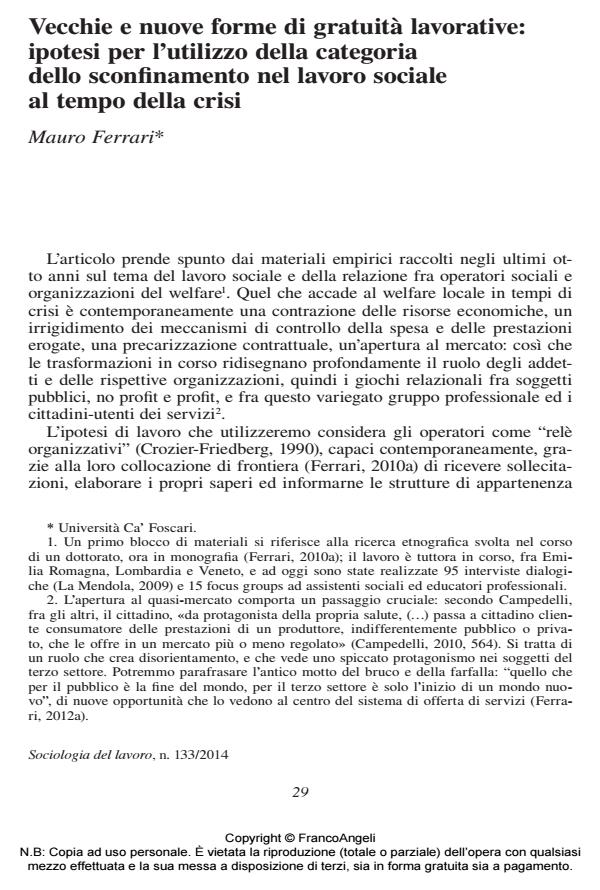Old and new forms of free work: hypothesis for the use of the category of trespassing in social work at the time of crisis
Journal title SOCIOLOGIA DEL LAVORO
Author/s Mauro Ferrari
Publishing Year 2014 Issue 2014/133
Language Italian Pages 13 P. 29-41 File size 586 KB
DOI 10.3280/SL2014-133002
DOI is like a bar code for intellectual property: to have more infomation
click here
Below, you can see the article first page
If you want to buy this article in PDF format, you can do it, following the instructions to buy download credits

FrancoAngeli is member of Publishers International Linking Association, Inc (PILA), a not-for-profit association which run the CrossRef service enabling links to and from online scholarly content.
Despite the increasingly difficult material conditions (both with respect to employment contracts and the available resources in favor of the citizen-service users) and organizational isolation (often they are left alone to deal with old and new social issues), the operators social act, activate, through a process of self-enactment (paraphrasing Weick, 1993). They choose, sometimes consciously, others not, to accept the challenge brought by the complexity of their work and to over come the frames dates, to explore, often "trespassing" in relation to the mandate. What does it mean, which kind of consequences, and especially what forms these take on different types of trespassing? We will discover that there are significant differences between the operators of the public sector (for which the trespassing on working time is combined with a kind of voluntary work, and is not recognized), and private social services, where instead the voluntary work carried out by the operators takes the form of a "value added". We’ll meet spurious forms, stumbling, which information unrelated to complement and support the set of options available to operators, and even forms of fluidity between work-time and extra-time, through the sharing of its social capital, up to a real "transgressive agreements" between colleagues and accomplices. Sometimes we will see communication moves inspired with a full awareness, where social actors choose to cross the frames to transform the ongoing relationship with its citizens-users in a fateful moment (Goffman, 2001), aimed to generating interactions unable to emerge in the organizational frames (rigid, scarce) of the locale welfare.
Keywords: Welfare, social work, learning organizations, self enactment, working practices, trespassing
- Professioni di confine. Indagine sulla ridefinizione del lavoro sociale Edoardo Esposto, Cecilia Ficcadenti, Francesca Messineo, in SOCIOLOGIA DEL LAVORO 155/2019 pp.74
DOI: 10.3280/SL2019-155004
Mauro Ferrari, Vecchie e nuove forme di gratuità lavorative: ipotesi per l’utilizzo della categoria dello sconfinamento nel lavoro sociale al tempo della crisi in "SOCIOLOGIA DEL LAVORO " 133/2014, pp 29-41, DOI: 10.3280/SL2014-133002